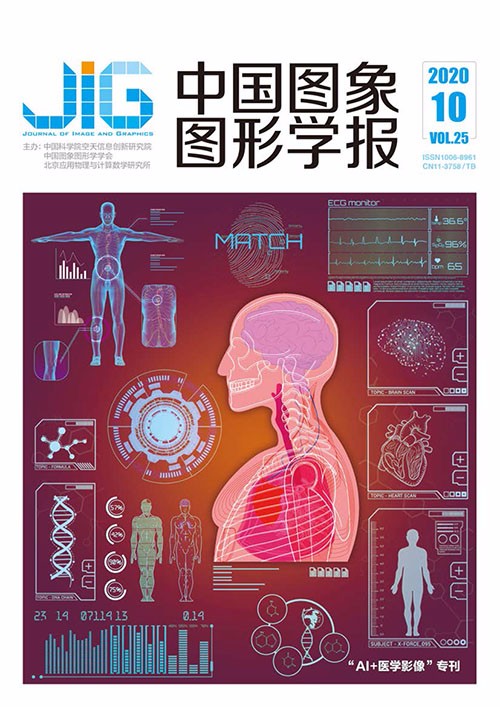
新型冠状病毒肺炎(COVID-19)医学影像AI诊断研究进展
摘 要
2020年3月,世界卫生组织(World Health Organization,WHO)宣布新型冠状病毒肺炎(corona virus disease 2019,COVID-19)为世界大流行病,疫情的爆发给世界各地医疗系统带来巨大压力。现有的COVID-19诊断标准是核酸检测阳性,然而核酸检测假阴性率高达17%~25.5%,为避免漏诊,需要采用基于影像学的AI诊断方法筛查大量疑似病例,扼制疾病传播。本综述将回顾疫情爆发数月以来,基于医学影像的新冠肺炎AI辅助诊断的研究成果。首先介绍CT(computed tomography)和X光片的优缺点,以及COVID-19的放射学特征,然后对数据准备、图像分割和分类识别等AI诊断的关键步骤分别进行阐述,最后介绍COVID-19的跟踪和预后(预先对疾病后续发展过程及结果的判断和估计)。本文还整理了部分公开的COVID-19相关数据集,并对数据标注不足的问题提供了弱监督学习和迁移学习等解决方案。实验验证,AI系统诊断COVID-19的敏感性达到97.4%,特异性达到92.2%,优于放射科医生的诊断结果。其中表现尤为突出的是基于语义分割网络检测COVID-19感染区域,由此可以定量分析感染率。AI系统可以辅助医生诊断和治疗COVID-19,提高放射科医生阅读X光片和CT的效率。
关键词
Progress of artificial intelligence diagnosis and prognosis technology for COVID-19 medical imaging
Meng Lu, Li Ronghui(College of Information Science and Engineering, Northeastern University, Shenyang 110004, China) Abstract
In March 2020, the World Health Organization(WHO) declared the new corona virus pneumonia (COVID-19) as a world pandemic, which means that the epidemic has broken out worldwide. The outbreak of COVID-19 threatens the lives and property safety of countless people and brings great pressure to medical systems. The main clinical symptoms of COVID-19 are fever, cough, and fatigue, which may lead to a fatal complication: acute respiratory distress syndrome. The main challenge in inhibiting the spread of this disease is the lack of efficient detection methods. Although reverse transcription-polymerase chain reaction (RT-PCR) is the gold standard for confirming COVID-19, it takes 4-6 h to obtain the results, and the false-negative rate of RT-PCR detection is as high as 17%-25.5%. Therefore, multiple RT-PCR detections at intervals of several days must be performed to confirm the diagnostic result. In addition, RT-PCR reagents are lacking in many severe epidemic areas. By contrast, X-ray and CT(computed tomography) examination equipment have been widely popularized in hospitals. In clinical practice, by combining clinical symptoms and travel history, CT is an efficient and safe method to diagnose COVID-19. Compared with CT, X-ray examination has faster scanning speed and lower radiation amount. Moreover, X-ray and CT images are important tools for doctors to track and observe the condition and evaluate the efficacy. In summary, medical imaging plays a vital role in limiting the spread of viruses and treating COVID-19. During the outbreak of the epidemic, medical imaging-based AI-assisted diagnostic technology has become a popular research direction. Computer-aided diagnostic technology improves the sensitivity and specificity of doctors' diagnosis and is accurate and efficient, which helps rapid diagnosis of a large number of suspicious cases. For example, the out preformed AI-assisted diagnosis system can achieve an accuracy rate comparable to that of radiologists, and it take less than 1 second to perform a diagnosis. The system has been used in 16 hospitals, with more than 1 300 diagnoses performed daily. This article reviews the latest research works on AI-assisted diagnosis of COVID-19 and analyzes and summarizes them on the basis of four aspects: data preparation, image segmentation, diagnosis, and prognosis. First, this article organizes some public data sets to support the AI-assisted diagnostic technology of COVID-19 and provides several solutions to insufficient datasets, such as the human-in-the-loop strategy, which improves the efficiency of data set production. Using transfer learning, weakly supervised or unsupervised learning can reduce model's dependence on the COVID-19 dataset. Second, the semantic segmentation network is also an indispensable part of the intelligent diagnosis of COVID-19. Segmenting the lung region from the original image is a key pre-processing step, which can reduce the calculation amount of subsequent algorithms. The lesion area helps the doctor to track the condition of the disease, and the infection rate can be calculated according to the size of the infected area. U-Net, U-Net++, and attention U-Net are suitable for the segmentation of medical images because of the small number of parameters, which is not easy to overfit. Furthermore, training the semantic segmentation network with the idea of the generative adversarial network (GAN) can improve the Dice coefficient. Third, this article introduces the AI diagnostic system from two aspects of CT images and X-rays. Comparing different diagnostic schemes, the method of diagnosis based on the segmentation images is better than that based on the original images. Among the classification networks, ResNet and VGG19(visual geometry group 19-layer net) perform better. Methods such as GAN, location attention mechanisms, transfer learning, and combining 2D and 3D features can be used to improve accuracy. In addition, clinical information (travel and contact history, white blood cell count, fever, cough, sputum, patient age, and patient gender) can be used as a basis for diagnosis. For example, algorithm D_FF_Conic uses clinical information as a diagnostic basis and has reached an accuracy rate of 90%. Clinicians will consider medical imaging and clinical information in the process of diagnosis, but the current AI diagnostic system cannot integrate multiple types of data for diagnosis. Although some algorithms can fuse the diagnostic results of medical images with the diagnostic results of clinical information, the simple fine-tuned algorithm haven't learned the deep internal connection between different types of data. Fourth, AI technology can also predict high-risk patients on the basis of infection rates and clinical information. Some research predicted the survival rate of COVID-19 patients on the basis of age, syndrome, and infection rate. Such algorithms can help doctors find and treat high-risk patients early, thereby reducing mortality, which is of great significance. This article shows the latest progress of COVID-19's medical imaging-based AI diagnosis. Although some AI-assisted diagnostic systems have been deployed in hospitals to play a practical role, these algorithms still have some problems, such as insufficient training data, a single diagnostic basis, and the ability to distinguish between non-COVID-19 pneumonia and COVID-19.
Keywords
artificial intelligence COVID-19 image segmentation computer aided diagnosis infection region segmentation
|



 中国图象图形学报 │ 京ICP备05080539号-4 │ 本系统由
中国图象图形学报 │ 京ICP备05080539号-4 │ 本系统由